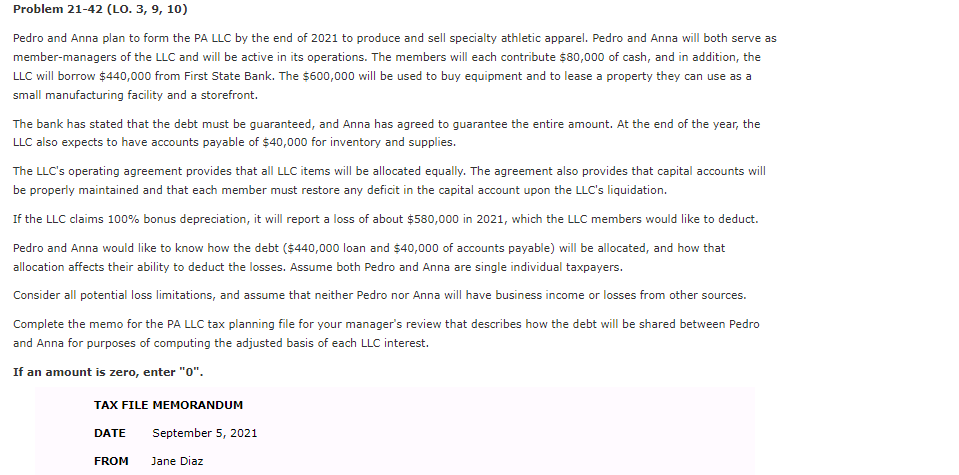
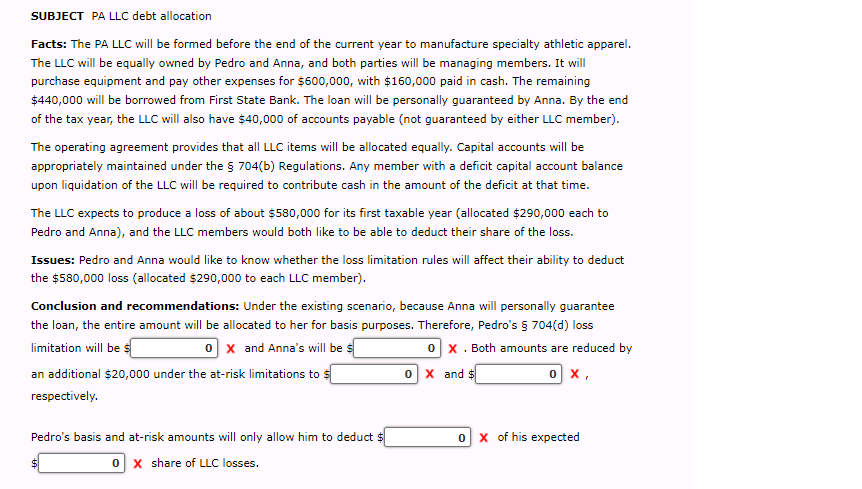
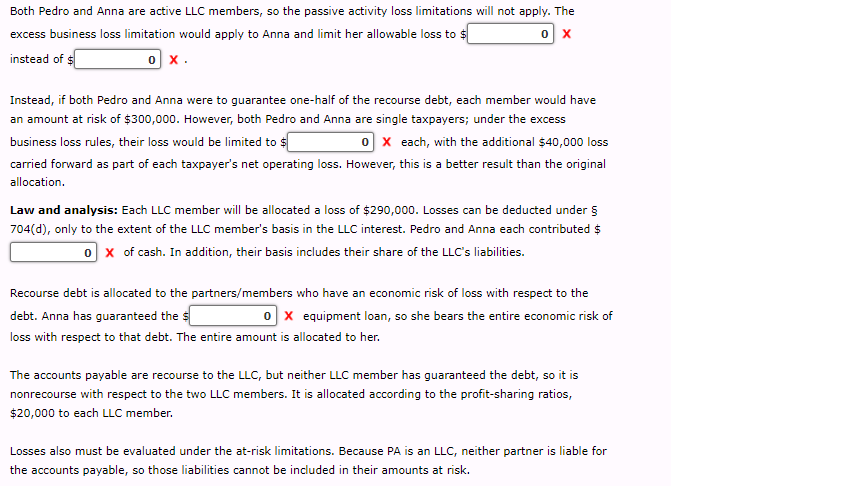
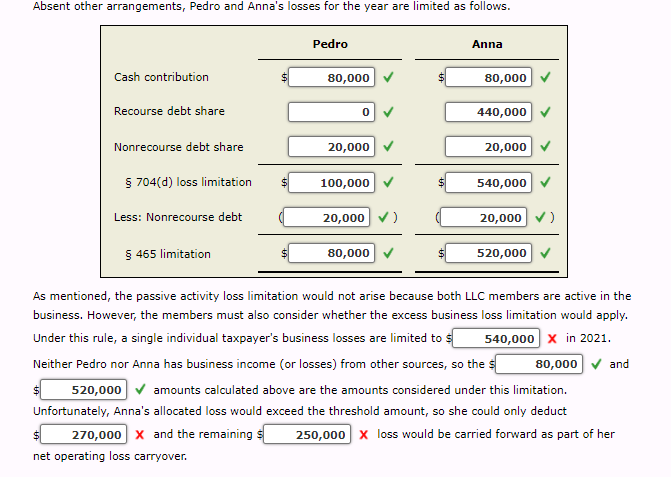
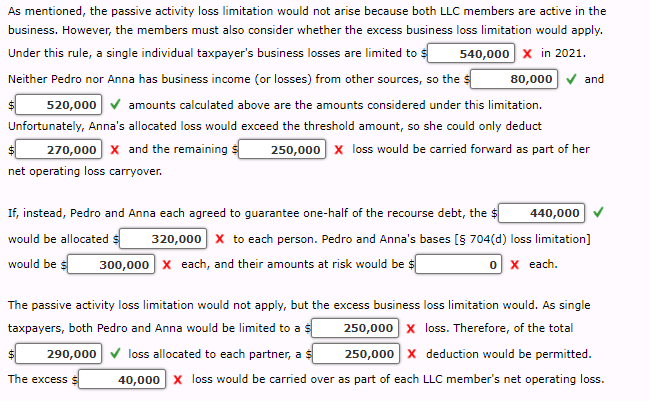
Problem 21-42 (LO. 3, 9, 10) Pedro and Anna plan to form the PA LLC by the end of 2021 to produce and sell specialty athletic apparel. Pedro and Anna will both serve as member-managers of the LLC and will be active in its operations. The members will each contribute $80,000 of cash, and in addition, the LLC will borrow $440,000 from First State Bank. The $600,000 will be used to buy equipment and to lease a property they can use as a small manufacturing facility and a storefront. The bank has stated that the debt must be guaranteed, and Anna has agreed to guarantee the entire amount. At the end of the year, the LLC also expects to have accounts payable of $40,000 for inventory and supplies. The LLC's operating agreement provides that all LLC items will be allocated equally. The agreement also provides that capital accounts will be properly maintained and that each member must restore any deficit in the capital account upon the LLC's liquidation. If the LLC claims 100% bonus depreciation, it will report a loss of about $580,000 in 2021, which the LLC members would like to deduct. Pedro and Anna would like to know how the debt ($440,000 loan and $40,000 of accounts payable) will be allocated, and how that allocation affects their ability to deduct the losses. Assume both Pedro and Anna are single individual taxpayers. Consider all potential loss limitations, and assume that neither Pedro nor Anna will have business income or losses from other sources. Complete the memo for the PA LLC tax planning file for your manager's review that describes how the debt will be shared between Pedro and Anna for purposes of computing the adjusted basis of each LLC interest. If an amount is zero, enter "0". TAX FILE MEMORANDUM DATE September 5, 2021 FROM Jane Diaz SUBJECT PA LLC debt allocation Facts: The PA LLC will be formed before the end of the current year to manufacture specialty athletic apparel. The LLC will be equally owned by Pedro and Anna, and both parties will be managing members. It will purchase equipment and pay other expenses for $600,000, with $160,000 paid in cash. The remaining $440,000 will be borrowed from First State Bank. The loan will be personally guaranteed by Anna. By the end of the tax year, the LLC will also have $40,000 of accounts payable (not guaranteed by either LLC member). The operating agreement provides that all LLC items will be allocated equally. Capital accounts will be appropriately maintained under the $ 704(6) Regulations. Any member with a deficit capital account balance upon liquidation of the LLC will be required to contribute cash in the amount of the deficit at that time. The LLC expects to produce a loss of about $580,000 for its first taxable year (allocated $290,000 each to Pedro and Anna), and the LLC members would both like to be able to deduct their share of the loss. Issues: Pedro and Anna would like to know whether the loss limitation rules will affect their ability to deduct the $580,000 loss (allocated $290,000 to each LLC member). Conclusion and recommendations: Under the existing scenario, because Anna will personally guarantee the loan, the entire amount will be allocated to her for basis purposes. Therefore, Pedro's $ 704(d) loss limitation will be $ 0 X and Anna's will be s 0 x . Both amounts are reduced by an additional $20,000 under the at-risk limitations to s 0 X and ox, respectively. Pedro's basis and at-risk amounts will only allow him to deduct $ 0 X of his expected 0 X share of LLC losses. Both Pedro and Anna are active LLC members, so the passive activity loss limitations will not apply. The excess business loss limitation would apply to Anna and limit her allowable loss to $ instead of $ ox. Instead, if both Pedro and Anna were to guarantee one-half of the recourse debt, each member would have an amount at risk of $300,000. However, both Pedro and Anna are single taxpayers; under the excess business loss rules, their loss would be limited to $ 0 X each, with the additional $40,000 loss carried forward as part of each taxpayer's net operating loss. However, this is a better result than the original allocation. Law and analysis: Each LLC member will be allocated a loss of $290,000. Losses can be deducted under $ 704(d), only to the extent of the LLC member's basis in the LLC interest. Pedro and Anna each contributed $ 0 X of cash. In addition, their basis includes their share of the LLC's liabilities. Recourse debt is allocated to the partners/members who have an economic risk of loss with respect to the debt. Anna has guaranteed the s 0 X equipment loan, so she bears the entire economic risk of loss with respect to that debt. The entire amount is allocated to her. The accounts payable are recourse to the LLC, but neither LLC member has guaranteed the debt, so it is nonrecourse with respect to the two LLC members. It is allocated according to the profit-sharing ratios, $20,000 to each LLC member. Losses also must be evaluated under the at-risk limitations. Because PA is an LLC, neither partner is liable for the accounts payable, so those liabilities cannot be included in their amounts at risk. Absent other arrangements, Pedro and Anna's losses for the year are limited as follows. Pedro Anna Cash contribution 80,000 80,000 Recourse debt share 0 440,000 Nonrecourse debt share 20,000 20,000 704(d) loss limitation $ 100,000 $ 540,000 Less: Nonrecourse debt 20,000) 20,000) $ 455 limitation $ 80,000 520,000 As mentioned, the passive activity loss limitation would not arise because both LLC members are active in the business. However, the members must also consider whether the excess business loss limitation would apply. Under this rule, a single individual taxpayer's business losses are limited to s 540,000 x in 2021. Neither Pedro nor Anna has business income (or losses) from other sources, so the s 80,000 and 520,000 amounts calculated above are the amounts considered under this limitation. Unfortunately, Anna's allocated loss would exceed the threshold amount, so she could only deduct $ 270,000 X and the remaining 250,000 X loss would be carried forward as part of her net operating loss carryover. As mentioned, the passive activity loss limitation would not arise because both LLC members are active in the business. However, the members must also consider whether the excess business loss limitation would apply. Under this rule, a single individual taxpayer's business losses are limited to s 540,000 X in 2021. Neither Pedro nor Anna has business income (or losses) from other sources, so the s 80,000 and 520,000 amounts calculated above are the amounts considered under this limitation. Unfortunately, Anna's allocated loss would exceed the threshold amount, so she could only deduct 270,000 X and the remainings 250,000 x loss would be carried forward as part of her net operating loss carryover. $ If, instead, Pedro and Anna each agreed to guarantee one-half of the recourse debt, the $ 440,000 would be allocated 320,000 X to each person. Pedro and Anna's bases ($ 704(d) loss limitation] would be sl 300,000 X each, and their amounts at risk would be $ X each. 0 The passive activity loss limitation would not apply, but the excess business loss limitation would. As single taxpayers, both Pedro and Anna would be limited to as 250,000 x loss. Therefore, of the total 290,000 loss allocated to each partner, a s 250,000 x deduction would be permitted. 40,000 x loss would be carried over as part of each LLC member's net operating loss. The excess s











